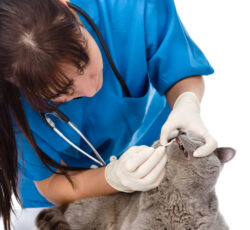
When it comes to your cat, their oral health is a huge indicator of how their overall health and wellness is progressing. Damage to your cat’s tongue, teeth, palate, and gums can lead to many health risks. If you notice color changes in your pet’s mouth, that can indicate dental and other medical issues.
Dental Issues to Look For
Your cat’s gums should be firm and pink, not white, black, or red, and should show no signs of swelling. The teeth should be clean and free of brownish tartar; none should be loose or broken.
The following could indicate issues in your pet’s mouth:
- Dark, red line along the gums
- Red and swollen gums
- Ulcers on the gums or tongue
- Loose teeth
- Pus
If your pet has difficulty chewing food, is excessively drooling, or seems to be frequently pawing at their mouth area, they may have a dental issue that must be addressed.
Common Mouth Disorders
There are some common mouth disorders to watch out for regarding your feline friends. See a vet immediately if your cat suffers from the following symptoms of these common disorders.
Gingivitis
This inflammation of the gums may start as a dark red line bordering on the teeth. Mainly seen in older cats, the gums may become sore, and ulceration may occur if left untreated.
Periodontitis
Periodontitis is almost always the result of untreated gingivitis. In periodontitis, the tissues that attach the tooth to the underlying gums and bone are weakened, leading to tooth loss.
Stomatitis
If your cat has difficulty eating and the inside of their mouth appears red, this could indicate stomatitis, an inflammation of the mouth lining.
Mouth Ulcers
Feline respiratory and kidney disease could cause ulcers on your cat’s tongue and gums.
Lentigo
Lentigo is a common condition in which black spots appear on the gums, lips, nose, and eye margins of orange, silver, and lightly colored cats. This condition typically develops in cats under one year old, with lesions potentially becoming more widespread as your pet ages. Lentigo is benign, but you should report any changes to your cat’s skin to your vet to rule out melanoma or other medical conditions!
Dental Care Solutions
Help avoid dental health issues by taking your pet for regular teeth cleanings. Plaque and bacteria buildup on your cat’s teeth can harden into tartar, causing gingivitis, receding gums, and tooth loss. Regular teeth cleanings can prevent these and other issues.
To brush your cat’s teeth, use cotton swabs, a small toothbrush, and a tube of toothpaste formulated for felines. You can also satisfy your cat’s desire to chomp and strengthen their teeth with specially designed chew toys that can work like floss to help clean tartar and plaque buildup between your pet’s teeth, massaging the gums and scraping away food buildup.
If your cat is recovering from a recent vet trip or you just want to pamper them with a cozy spot to lounge, The Cat’s Inn has handmade cat beds and pillows to keep your feline friends comfortable. Our cat beds are suitable for any small to medium-sized cat that weighs up to 16 pounds, and our pillows are available in various colors and styles and are fully washable!
If you are a veterinary clinic looking for safe housing for your feline patients while they wait for their oral health checkups, our commercial cat enclosures are the perfect place to keep them comfortable.
Contact us at (877)228-7466 to learn about your cat housing options for your residential or commercial cat care needs!
